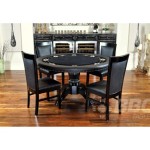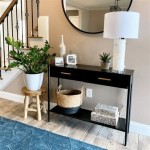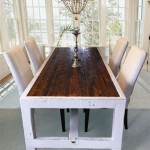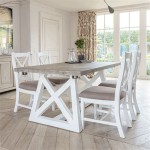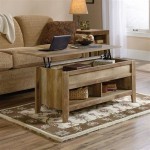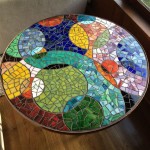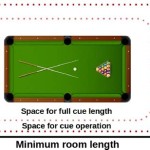Mid-Century Modern Coffee Tables With Drawers: Form and Function Combined
The mid-century modern aesthetic, characterized by clean lines, organic shapes, and a focus on functionality, continues to resonate in contemporary interior design. Among the most iconic pieces of furniture from this era is the coffee table, particularly those equipped with drawers. These tables offer a practical solution for storage, seamlessly blending form and function, and making them a highly sought-after addition to living spaces. This article will explore the defining characteristics, materials, design variations, and practical considerations surrounding mid-century modern coffee tables with drawers.
The mid-century modern movement, which flourished roughly from the 1940s to the 1960s, emphasized simplicity and accessibility. Furniture designs during this period often incorporated natural materials, such as wood, and avoided excessive ornamentation. The influence of Bauhaus principles, which prioritized functionality and mass production, is evident in the clean lines and minimalist forms of mid-century modern furniture. The integration of drawers into coffee tables was a direct response to the need for practical storage solutions within homes, particularly in smaller, post-war living spaces.
The resurgence of interest in mid-century modern design can be attributed to several factors. First, the clean, uncluttered aesthetic provides a sense of calm and order, appealing to those seeking a respite from the complexities of modern life. Second, the use of natural materials and organic shapes creates a warm and inviting atmosphere. Finally, the inherent functionality of mid-century modern furniture, such as coffee tables with drawers, makes it a practical choice for contemporary living.
Key Features of Mid-Century Modern Coffee Tables With Drawers
Mid-century modern coffee tables with drawers possess a distinct set of features that define their aesthetic and functionality. These features contribute to their enduring appeal and their ability to complement a wide range of interior design styles.
Clean Lines and Geometric Shapes: The hallmark of mid-century modern design is its emphasis on clean lines and geometric shapes. Coffee tables typically feature rectangular, square, or oval tabletops, often supported by tapered legs. The drawers, when present, are seamlessly integrated into the overall design, maintaining a sense of visual harmony. Sharp angles are softened with slightly rounded edges, creating a balance between modern and organic forms.
Tapered Legs: A defining characteristic of mid-century modern furniture is the use of tapered legs. These legs, often made of wood or metal, slant outwards from the tabletop, creating a sense of lightness and visual interest. The tapered design contributes to the overall aesthetic, giving the table a floating appearance and preventing it from feeling heavy or bulky. The legs are typically attached to the table frame using a variety of techniques, including dowels, screws, or mortise and tenon joints, ensuring stability and durability.
Minimalist Hardware: Hardware on mid-century modern furniture is typically understated and functional. Drawer pulls are often simple and geometric, made of metal, wood, or plastic. Recessed pulls are also common, further minimizing visual clutter and maintaining the clean lines of the design. The choice of hardware plays a crucial role in complementing the overall aesthetic of the coffee table, adding a subtle touch of elegance without overpowering the design.
Materials Commonly Used in Construction
The materials used in the construction of mid-century modern coffee tables with drawers contribute significantly to their aesthetic and durability. The selection of materials often reflects the natural and organic principles of the design movement.
Wood: Wood is the most common material used in mid-century modern coffee tables. Teak, walnut, and birch were particularly popular choices, owing to their warm tones, beautiful grain patterns, and durability. Teak, known for its resistance to moisture and decay, was often used in furniture intended for outdoor use. Walnut, with its rich, dark color and prominent grain, was favored for its luxurious appeal. Birch, a lighter-colored wood, provided a versatile option that could be stained or painted to match a variety of interior design schemes. Solid wood construction was common, ensuring the longevity of the furniture. Veneering techniques were also employed, often using high-quality wood veneers applied to plywood or particleboard substrates.
Metal: Metal, typically steel or brass, was often used for legs, hardware, and decorative accents. Steel legs provided strength and stability, while brass accents added a touch of elegance. The use of metal was often limited, complementing the wood rather than dominating the design. Metal finishes were typically brushed or polished, further enhancing the aesthetic appeal.
Formica and Laminates: In some cases, formica or other laminates were used for tabletops or drawer fronts. These materials offered a durable and easy-to-clean surface, making them a practical choice for families. Formica was available in a wide range of colors and patterns, allowing designers to experiment with different aesthetics. While not as highly valued as solid wood, formica-topped coffee tables were a common and affordable option during the mid-century modern era.
Design Variations and Functional Considerations
Mid-century modern coffee tables with drawers are available in a variety of design variations, reflecting the diverse aesthetic preferences of the era. The functionality of these tables is enhanced by the inclusion of drawers, providing valuable storage space.
Single Drawer Designs: Some coffee tables feature a single, centered drawer, providing discreet storage for remote controls, magazines, or other small items. These designs often prioritize simplicity and minimalism, with the drawer seamlessly integrated into the overall form. The drawer pull is typically understated, maintaining the clean lines of the table.
Double Drawer Designs: Coffee tables with two drawers, positioned on either side of the table, offer increased storage capacity. These designs often feature symmetrical layouts, creating a sense of balance and harmony. The drawers can be used to store a variety of items, such as books, blankets, or games. The double drawer design is a popular choice for larger living spaces where ample storage is required.
Combination Designs: Some coffee tables combine drawers with open shelving, providing a versatile storage solution. These designs offer a balance between concealed and displayed storage, allowing homeowners to showcase decorative items while keeping clutter out of sight. The open shelves can be used to store books, plants, or other decorative objects, adding visual interest to the living space.
Drawer Construction and Functionality: The construction of the drawers is an important consideration. Dovetail joints, known for their strength and durability, were often used to join the drawer sides. Drawer glides, typically made of wood or metal, ensure smooth and effortless operation. The size and depth of the drawers should be considered based on the intended use. Smaller drawers are suitable for storing small items, while larger drawers can accommodate larger objects.
Size and Proportion: The size and proportion of the coffee table should be carefully considered in relation to the size of the living room and the surrounding furniture. A coffee table that is too large can overwhelm the space, while a table that is too small may appear insignificant. The height of the coffee table should be approximately the same as the height of the sofa cushions, allowing for comfortable reaching. The length of the coffee table should be approximately two-thirds the length of the sofa, creating a balanced and harmonious composition.
Placement: The placement of the coffee table is crucial to its functionality and aesthetic appeal. The table should be positioned within easy reach of the sofa and chairs, allowing for convenient placement of drinks, snacks, or books. Sufficient space should be left around the table to allow for easy movement. The coffee table can also be used to define the seating area, creating a focal point in the living room.
The enduring appeal of mid-century modern coffee tables with drawers lies in their ability to seamlessly blend form and function. Their clean lines, natural materials, and practical storage solutions make them a timeless addition to any living space. Understanding the key features, materials, design variations, and functional considerations associated with these tables allows homeowners to make informed decisions when selecting a coffee table that complements their individual style and needs.

Mid Century Coffee Table Vintage Storage Unit Scandinavian Nordic Shelf Drawer Unique Home Furniture

Mid Century Storage Coffee Table 122 Cm West Elm

Mid Century Storage Coffee Table Modern Living Room Furniture West Elm

Stylish Solid Wood Walnut Coffee Table 4 Drawers For Living Room
Jual Coffee Table Plus With Drawer Handmade Solid Wood Mid Century Modern Style And Storage Cubby Shopee Indonesia

Smool Mid Century Modern Retro Coffee Table With Storage Drawer Wooden Finish Walnut Brown Walmart Com

Welwick Designs 48 In Caramel Rectangle Solid Wood Mid Century Modern Storage Coffee Table With 3 Drawers Hd9538 The Home

Safavieh Mozart Mid Century 2 Drawer Coffee Table Brown Walmart Com

Caramel 1 Drawer Mid Century Modern Coffee Table Kirklands Home

Mid Century Coffee Table W Drawers Cubby Storage Rolling Locking Wheels Black Ebay

